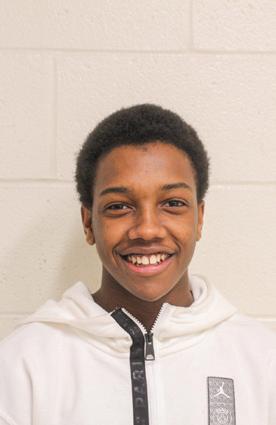THE HOOFBEAT







Front-Page Editor
or some prom attendees, the struggle arises in which dress to buy, or which ties and shoes will best match their date’s. For others, the struggle is in staying up late enough to enjoy the festivities of After Prom. But for members of the Junior Class Board, there is much more to do, and much more to plan.
With their hands in almost every facet of the night of prom, from decorations to food, and even in budgeting, members of JCB, like junior Cali Wisdom, have a lot riding on their shoulders.

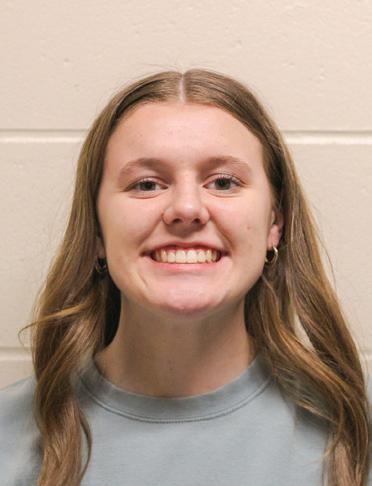
“At the beginning of [preparations], my role was to reach out to corporations that were going to be helping us with prom preparations,” Wisdom said.
As time has passed and prom preparations draw to a close, Wisdom, who is the Head Decorator, is in the works of bringing her part of this production to perfection.
“I coordinate with all of the people that have to do with decor – I’ve had to email light letter, balloon, and tablecloth sellers, and am now going online and finding more decorations that fit this year’s theme,” Wisdom said.
Every Monday after school, Wisdom and her fellow JCB members, including junior Thanks Ndichafah, meet to discuss their progress.
“As a member of the invitations preparation section, we designed various invitations and had our fellow JCB members vote on whichever ones they liked,” Ndichafah said. “Along with our Monday discussions, we have an iMessage group that we text each other on to figure out what we’re doing and how things are going.”
These Monday meetings are more than just discussion, though. Junior Shalom Manyara and her teammates, who are members of the activity section of the JCB, introduce and present their ideas to the attendees of these meetings.
“At these meetings, we bring our ideas and we then vote [as a group] to decide on each other’s preparations. These meetings entail a lot of discussion and we receive a lot of input from our fellow members,” Manyara said.
In tandem with the publicity that Ndichafah and others in the invitations group provide for prom, secrecy takes place as Manyara and her fellow activity group members prepare to create a Saturday night to remember.
“Although this year’s events are still a surprise, my partners and I are coordinating fun activities to make prom more than just dancing in a room,” Manyara said.
As a group, and in Manyara’s section as well, multiple factors must be considered in creating an amazing experience for all attendees.
“Lights, colors, decorations, and much more come into consideration as we plan and prepare for the activities that prom will have,” Manyara said.
With their hands in many of the facets of prom, Wisdom, Ndichafah, and Manyara are missing two more important facets of prom-food and social media preparations, managed and covered by junior Riya Pawar.
“A lot of my job is asking the public what they want for prom, and about any ideas they might have for our prom playlist and for spirit week,” Pawar said.

Acting as a user interface for the general public to have a say in the goings-on at prom, Pawar, who is a JCB Officer takes her groups through the preparations.
“Although some of our suggestions aren’t as popular as others, the members of JCB are very committed, and it works out very nicely,” Pawar said.
As busy students in their third years of high school, members of the Junior Class Board have set aside time to attend to their work weekly in order to promote, prepare, and plan for this year’s Masquerade Ball.
“We made blueprints of what we wanted first, and we’ve been putting together centerpieces, which I enjoy a lot.”
ON MARCH 25TH, MN’S PROM WILL BE HELD AT BAXTER ARENA, FROM 8:00 TO 11:00 PM.
AFTER THE MAIN PROM EVENT, FROM 11:30 PM TO 4:00 AM, COME TO MILLARD NORTH AND ENJOY THE FESTIVITIES!
“Every invitation that students receive is designed on Canva, and we also made bracelets and posters, which was fun.”
“Basically, we designed an acitivty for students to do at prom, as well as different prizes and a raffle - it’s a good time.”
Corsage and Boutonniere -

For the floral duo, whether you decide on to match colors or flower types, this style option is a simple yet solid first choice.
Zorinsky Lake
A lake with a stunning backdrop—Zorinksy is already a top spot for all kinds of photos.

Clothing Material



For the better-prepared prom duo, matching clothing materials is an impressive styling option, but beware, it may prove to be difficult.
Color Palette -

For those that enjoy a simple, good-looking match, coordinating color themes is a notso-subtle way to elevate your prom attire, and the best part is, it can be as last-minute as you’d like.

Underground DowntownA beautiful, floral location—but beware. No professional photography is allowed at this location—so phone cameras it is.

What do you enjoy about after prom?
I enjoy seeing the surprise on all the student’s faces when they see all that they get for only $15. They have so much fun wandering around trying to take in the whole event, the games, inflatables, the food, the hypnotist shows, and even Mr. Diehl, who will be doing trivia the last hour of the night!
What’s after prom doing this year?
This year our theme is “Adventure Awaits”. It opens up many different destinations we have had fun developing around the school. The whole first floor of the school is transformed including the cafeteria. The local community as well as your parents, neighbors, grandparents, and possibly your siblings volunteer their time and money to make this event a safe and inclusive experience for you all. You don’t have to go to Prom in order to come to After Prom!

Unofficial final vote totals for the MPS tax levy override showed 60% in favor of the override and 40% against it (Mar. 14)
In today’s age, being tech savvy is not a skill but a requirement. Technology is everywhere, and being left in the dark isn’t an option. As new students roll in, the school is taking a different approach on what is required for graduation. Incoming freshmen and beyond are now required to take one computer class as a graduation requirement.
President Veta Jeffrey of the Greater Omaha Chamber of Commerce leaves position with no explanation (Mar. 15) Biden administration approves the Willow Project in Alaska, a project to increase oil production in Alaska that will have effects on the climate (Mar. 13) California close to passing a 30 year snowfall record, with many areas of the state surpassing 50 feet of snow (Mar. 15)
Two Americans returned to the U.S., two found dead out of the four kidnapped in Mexico (Mar. 7)
Russian fighter jet collides with U.S. military drone over the Black Sea. The drone had to be crashed into the sea (Mar. 14)
Business department head Jeff Gustafson is in charge of deciding what computer class, or even classes, the incoming students have to take.
“The decision [on required computer classes] was made at the district level. They just passed a state law that requires all high school students to take a high school [computer] class,” Gustafson said.
This new law in place also adds new opportunities for students. It allows students to be more aware of how to use technology. Most students are unaware of how to use technology in a positive light, when the world revolves around posts about their lives online.
Assistant principal Mary Bayne is in charge of requiring students to take the new, in place classes. Though most students say they have the ability to use technology, it is different when applying it in the real world with jobs. Knowing how to text doesn’t make one “tech-savvy.”
“In the classes, it’s [safety] embedded. Though this probably starts in elementary school– I don’t want to say
you learn how to be cautionary– but [it] helps teach you good skills on putting yourself out there on social media and what to do and not do,” Bayne said.
Technology is the new face of businesses. With many jobs focused on using technology to be known, students need the skills of typing, cybersecurity, and how to move around on the Internet safely. In past years, students had to learn typing skills, but the required classes allow them to explore in different ways what they are interested in.

“It’s not just keyboarding [as an option]– some kids, they want to go into graphic art more. Some want to do the business side of it. So then we have a lot of choices to fulfill that requirement. It’ll appeal to the different passions of kids,” Bayne said.
Some students have a different take on the new requirements. Junior Amelia Wheeler disagrees with bringing these classes back.
“I personally think that it shouldn’t be a requirement. Because we have been taking computer classes since the sixth grade,” Wheeler said.
Freshman Peyton Kragskow also believes that this new requirement isn’t needed.
“I think that most students coming up already know how to use technology properly,” Kragskow said.
Having this all in mind, upgrading and updating is something that is inevitable. So, keeping up with technology and the times is what is not only important for the present generation, but also technology of the future–shaping our world in ways we didn’t know possible.
Classes that will fulfill the technology requirement and what you will learn in them
AP

Emerging Technologies
Computer Science Programming
ELD Computer Literacy
Business Technologies
Introduction to Engineering
Information Technology I (STEM Academy)
71% of U.S. students say they use laptops in the classroom, compared to the global average of 37%
3.12 million IT employees as of Jan. 2023
Source: McKinsey & Company, Statista
Learn communication techniques
Produce digital media and use industry standard tools for multimedia production
Learn computational productivity
Use 3D software to learn the basics of robotics, engineering, architecture and design
Practice digital citizenship
Learn to code
Explore different IT-related concepts such as project management, security, databases and graphic design
In these classes you can...
very day, as students walk into our school, we see countless staples of the environment: posters advertising clubs on bulletin boards, teachers standing outside of their classroom doors, breakfast being eaten in the cafeteria, and security guards patrolling the hallways to keep us safe.
Lately, a new sight has entered the scene: additional security guards, the patches on their jackets emblazoned with the word “Frontline.” These security guards may appear unfamiliar to students, but MN and Millard have contracted Frontline Security– a security company in Omaha– before. Originally, they were hired to be security for the parking lots and during nights.
“We use Frontline to supplement the security systems and people we deploy. For example, we currently use Frontline to respond to after hours building alarms that may be triggered and we also use them for after hours patrols when necessary,” Millard Director of Student Services Bill Jelkin said.

Recently, it became necessary for Frontline Security to become more involved in the district. Specifically at MN, security staff had left for various reasons, and the applicants to fill security guard positions were slim. This led to the administration having to hire Frontline Security workers as campus staff to fill the gap.

“We had people [security guards] here for the first semester, we had pretty much close to a full crew, but then we had some people changing positions, going somewhere else in the district,” MN campus security guard Ryan Miksch said. “So [the] beginning of second semester was really kind of challenging, just because there was a few of us here that were left, and we had a lot more stuff to do.”
This deficit of campus security also affected Millard South, who have had to contract Frontline Security as well. Assistant principal Mary Bayne, who oversees safety
and security, attributes this need to the hiring struggles sometimes experienced by certain job areas.
“I think it’s running the trend of a lot of things. People are not taking those types of jobs, like when you go to a restaurant, and there aren’t enough waiters; you’re finding it everywhere. We’re the victim of that also,” Bayne said.
Proof of this dip in hirees to fill school needs is shown in the numbers for security guards district wide. Millard South, West, and MN each get five security guards, and Horizon and Central Middle School are each allotted one. But Millard is currently only employing 12 out of these 17 positions. That is where Frontline comes in.
There are currently three Frontline workers who are filling those empty positions within the district. However, it is not always the same Frontline security guard working in a building. Sometimes, a worker is switched out or gets sick and is replaced by a Frontline worker who is new to the school. When this happens, there is a learning curve and the new security guard must be taught Millard and MN protocols.
“When you get new people, and then the next week is someone new, and the next week is someone new, then that’s a training process over and over and over again. So it’s been more labor intensive…It’s just like every time you get a new person, you have to communicate more,” Bayne said.
Although there is somewhat of a learning curve for the Frontline Security guards, their job is still the same as the MN security workers. One difference for Frontline,

however, is that they must acclimate to the environment of a school with many new students and staff to interact with.



“Typically it’s the same mission: the job of keeping students, faculty and the campus safe and secure,” Miksch said. “They’re [Frontline security guards] just new, so they have less interaction with students, just [because] they don’t know anyone.”
Despite the difficulties from the occasional turnover of the Frontline Security guards, and their initial unfamiliarity with students at the school, the security company’s presence has been appreciated at MN.
“I think anytime you have more eyes on the building, on the kids, on the hallways, bathrooms, things like that, that helps out a lot,” Bayne said.
In spite of Frontline’s benefits, the primary goal of Millard is to be able to rely on and have enough of their own security guards, rather than have to use a contractor. This process will depend on when Millard receives and screens enough worthy applicants that they can hire, so they can transition out of using Frontline Security.
“Certainly paying more money per hour helps, but when we are talking about staff who have daily contact with kids, it is more about finding the right people with the right personalities and the right demeanor to do this campus security work,” Jelkin said.
Frontline Security is a now necessary aspect of our school, contracted in order to fulfill the amount of security guards needed to keep students safe and secure. The school is also looking forward to being able to hire and rely on our own security guards in the near future.
“That’s always the hope, that we can get more people to apply, get more security guards hired,” Bayne said.

“ We just try to keep the building fully staffed if at all possible. BILL JELKIN MPS DIRECTOR OF STUDENT SERVICES
”
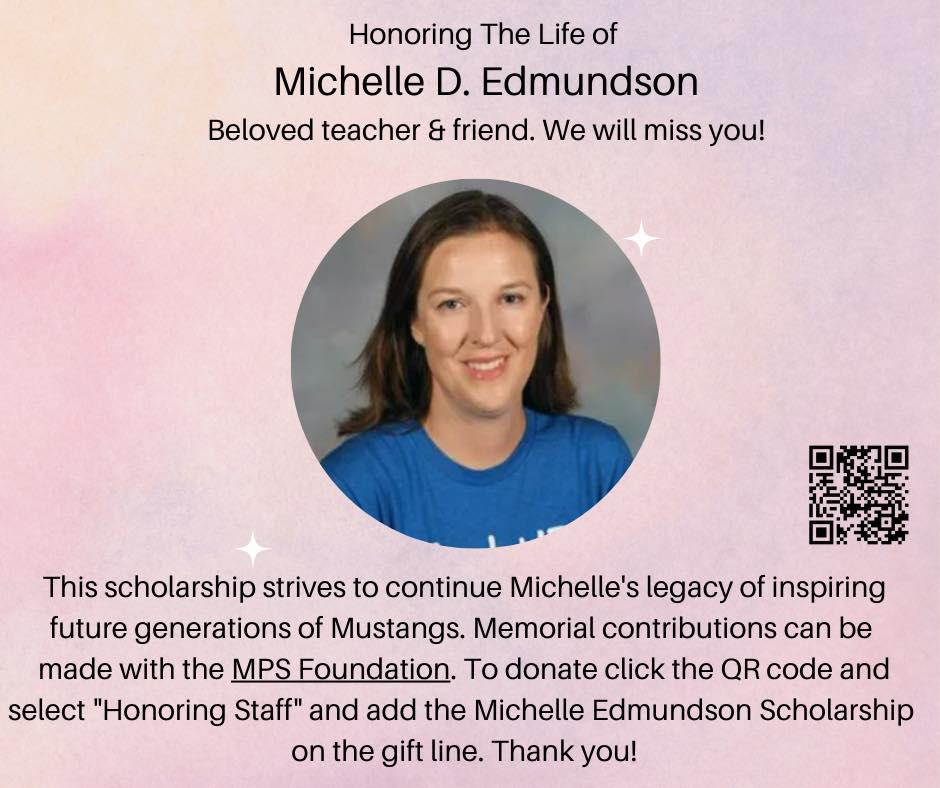 ANUJ SINGH Online Editor
ANUJ SINGH Online Editor
MN teacher Michelle Edmundson was a woman of many talents. An avid climber and hiker who was heavily involved in Project Pink’d, an organization that helps patients fighting breast cancer, she was driven by one mission above all else– to change the world.
And she did, through her bravery, determination, and kindness that touched so many people, from students to fellow teachers to parents, until her passing last November.
In her honor, one of her best friends and fellow social studies teacher Jessica Hacker set out to establish the Michelle Edmundson Scholarship.
“It is primarily designed to remember the legacy that Mrs. Edmundson left at MN. The scholarship will be directed to seniors who have a parent who has been affected by cancer,” Hacker said.
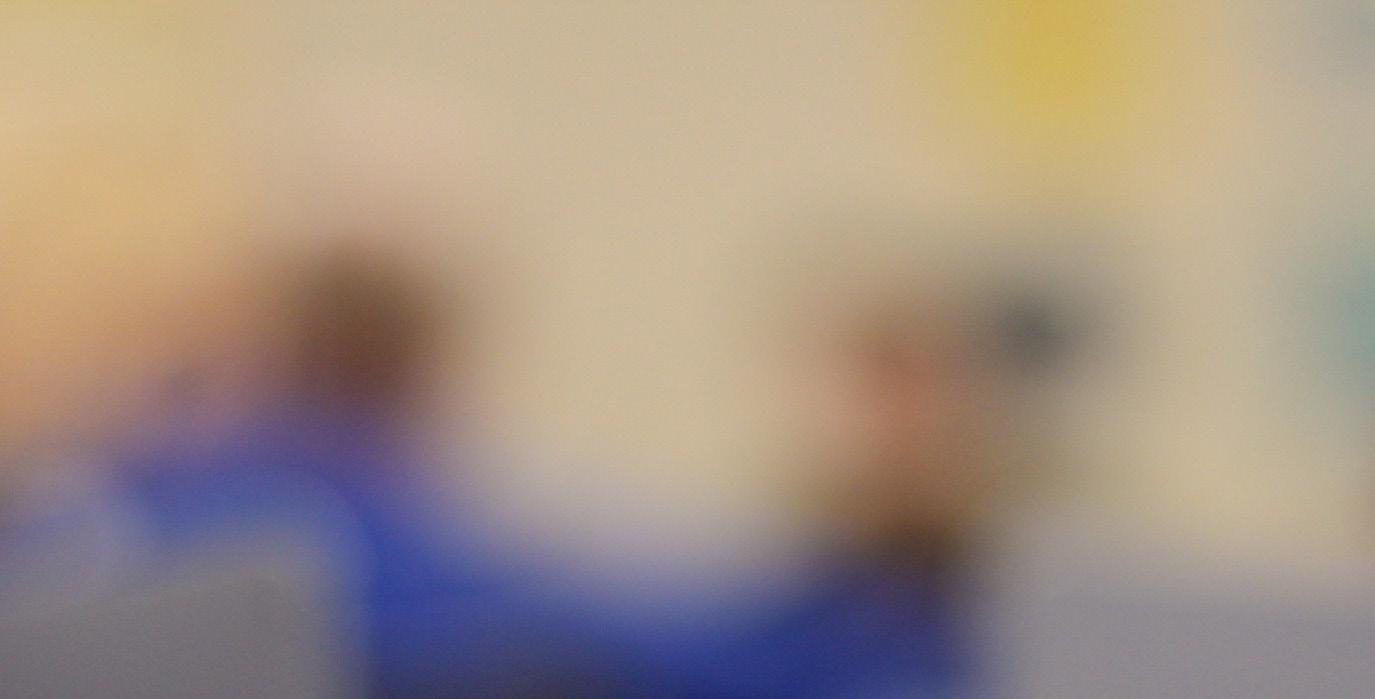
The scholarship will provide a stipend of $2,500 to the recipient. This money will be used to help students attend college, who otherwise might not have been able to afford it.
“It’s very possible that monetarily, [the scholarship] could make it possible for the student to attend college. Cancer can devastate a family financially and emotionally,” athletics and activities administrative assistant Kathy Folk, who was involved with fundraising for the scholarship, said. “[The money from this scholarship] could mean the difference between going and not going.”
This scholarship exemplifies Edmundson’s giving spirit, which has been described by students, colleagues, and friends alike.
“She had the biggest heart of anyone I knew. To go through what she did for so many years and to be at work every day, giving one hundred percent to her students, I don’t think there could be a better example of not giving up,” Hacker said.
and that was all it took. I just sent a reminder out a few days before, and it just happened. That’s how caring this community is. It was an idea that just came together,” Folk said.
But similar to Hacker, Folk feels that she didn’t have to do much planning because of the overwhelming support and care that the MN community put into supporting this scholarship.
teacher
Jacob Bergmeier serves himself during the Souper Bowl fundraiser. The Souper Bowl raised over $2,600 for the scholarship.
Photograph by Jack Durkan
Though Hacker was the driving force behind the scholarship, MN’s community ultimately came together to make the scholarship possible.
“There’s been overwhelming support for it. The MN community is amazing. We truly are like one big family,” Hacker said.
To raise funds for the scholarship, social media has been a major driving force.
“There is a link in the MN website for people to donate through. A lot of people reached out to ask how they could help,” Hacker said.
Additionally, in February, Folk planned a ‘Souper Bowl,’ a fundraiser that raised over $2,600. Themed around the Super Bowl, staff members could purchase soup and desserts to raise money for the scholarship.
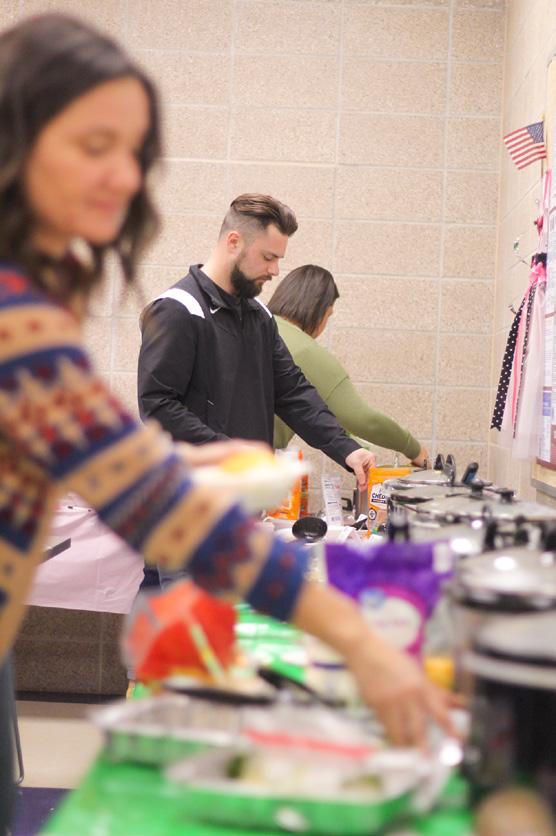
“We designed a flier and sent out a Google Form,
“I lost track of how much food the staff members contributed to [the Souper Bowl]. I don’t know that there was a teacher in this building that didn’t come down [to contribute] by buying lunch. The staff lounge was busy for all of fifth period,” Folk said.
One of the faculty members who was involved in the fundraiser and contributed to the scholarship was IB DP coordinator Rhonda Betzold. Betzold made a soup for the Souper Bowl and also donated money through social media.
“[I donated because] I loved Michelle, and feel her loss deeply. She was the kind of teacher who impacted lives for the good of our world. I believe the scholarship will keep her memory alive and inspire others to make the world a better place,” Betzold said.
Hacker hopes that implementing this scholarship will help establish a legacy to remember Edmundson and all of the courage and compassion she embodied.
“I know that 20 years down the road, students might not know Mrs. Edmundson. But we want students to know that we see you and we understand that dealing [with cancer] takes a piece of you. And if this scholarship can help in any small way, that is our goal,” Hacker said.
While Edmundson may no longer be here, her legacy will live on forever. The scholarship will immortalize the life she lived– full of grit, determination, and most of all, love– as well as the statement she defined her life by: be the change you wish to see in the world.
Edmundson had a collection of about 1,000 ducks. This collection started as her own, but students would also give ducks to her.
ducks

and
fun hearing about all the different stories she made behind each one.
ent. It was
“
The
were all really cool
very differ-
really
Mia Kosel Sophomore
”
n January 31st, across Omaha, adults return to their homes exhausted from their seemingly never-ending work day, which is about to get longer.
Lazily, they sprawl out on their couches and flick on the news to see large words flash across their pixelated screens, reading “Breaking News: Omaha Police Kill Gunman Inside Target at 178th & Center”, as the image of a Target store appears in the background.
Their chests pounding and their palms sweaty, their shaky fingers barely press the right keywords in Safari to search for more information on the attack.
They scour the internet in hope that no bystanders were hurt, the only thought running through their heads being: how could this have happened?
If there are laws in place to protect us from this terror, why do these kinds of tragedies continue to occur in our lives?
Gun safety isn’t spoken about enough in a progressive manner and for that reason and others, it’s crucial we inform ourselves about the topic.
According to Everytown for Gun Safety, an organization that promotes firearm safety awareness, every day, on average, 316 people in America sustain injuries from gun violence, ranging from attacks to unintentional accidents.
The Gun Violence Archive states that there were 647 mass shootings in 2022 and 692 in 2021, marking the most fatal year since the Gun Violence Archive began
tracking mass shootings in 2014. These onslaughts can happen anywhere, from malls, stores, schools, and other public places.
Either way, these stats pose the overwhelming, but valid inquiries, what gun safety rules are there? How effective are they? What is gun safety?
Joseph Jones, the man who opened fire at the West Omaha Target store on Jan. 31st, 2023, had been repeatedly admitted into several psychiatric institutions for schizophrenia and paranoia, as reported by Jones’ uncle. Therefore, he was in no shape to bear ownership of a gun.
Federal law states that it is unlawful to buy a firearm from or sell a firearm to someone that has previously been “adjudicated as a mental defective or has been committed to any mental institution,” as worded in the law description.
Jones had been mentally “defective,” to say the least.
Recent local traumas like the Target shooting and teen Blake Miller’s gun mishandling incident have exposed major gaps in the arms control system on the federal and state level.


On March 12, 2022, 18-year-old Blake Miller was “messing around” and consuming alcohol with his best friend, Tanner Farrell, and three other friends. They were at Miller’s residence when Miller allegedly grabbed a gun left unlocked in his room, pointed the gun at Farrell’s chest, and pulled the trigger, believing it was unloaded. 911 was called by one of the boys at the scene, but it was too late.

Farrell later died in a hospital.
The question that now arises is: how did Miller have such easy access to a gun, especially under alcoholic influence?
Also, why did Jones have a gun in the first place, with his history of mental troubles?
While the US has laws like the Gun-Free School Zones Act to prevent school shootings, and the Omnibus Crime Control and Safe Streets Act that declares 21 years of age the minimum to purchase a gun, it’s clear that they aren’t enough because of the occurrences of gun violence we’ve seen in Omaha recently.
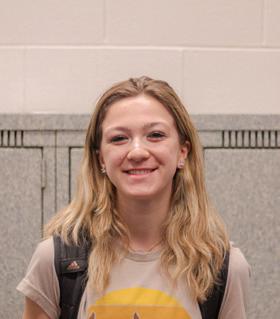
It is our responsibility to educate ourselves and others about gun safety laws and what’s going on in our city. Staying alert is key.
Any person with access to a mobile device and the internet can find tips to keep you and your loved ones safe from firearm threats. Doing this can help prevent terrifying tragedies no one wants to go through.
If we look after one another and respect the environment we share, we will stop living in fear that family members won’t return from shopping at the Target store nearby or from their trusted best friend’s house.
Guns have many uses, and while the one the common American population is familiar with is recreational use, that doesn’t take away from the true dilemma of armed violence in the world around us.
Aldous Huxley, an acclaimed English writer, once said, “facts do not cease to exist because they are ignored.”
The stats speak the facts– that has been proven. Now, how will we stop ignoring the situation at hand?
 By Violet Bredenkamp
By Violet Bredenkamp
“Prom, because you get together and have a good time. You’ll remember it for your whole life—you look back and it’s one of the big events of your high school career.”
“I like when they decorate the hallways before our final week of show choir competitions.”
“After prom because we’re not just dancing for four hours. There’s a lot of stuff to do. You get to spend time with your friends and hang out and play games.”
“Going all out for sports events and dressing up (for them).”MAX REIFF SENIOR SRILA PRATHIVADHIBHAYANKARAM SENIOR
Most kids realize by the end of their freshman year that high school is nothing like the movies. Each teen flick we watched gave us an unachievable idea of what our high school lives should look like. And at MN, we lack the high school traditions predominantly glamorized in the movies.
MN lacks traditions like voting on students for school royalty, recognizing high-achieving students for valedictorian, and creating senior quotes. School royalty and senior quotes are a school decision, but valedictorians were changed many years ago from the Millard school district.

There can be issues with awarding prom king and queen that may cause some students’ feelings to be hurt. According to Principal Aaron Bearinger, in past years students have been voted for as a popularity contest and it has been difficult to make fair. But as students, we don’t have to take the competition too seriously, if the voting is just for fun then it’s a great opportunity for spirited
to be recognized.
“I was voted most school spirited when I was in high school and I want our students to be engaged in our school. However, I think we need to go about our business in the right way, which is creating a welcoming and positive school for all students. I will always listen to new ideas,” Bearinger said.

The school also does not nominate a valedictorian. While many students excel in academics, there are also plenty of students who deserve to be recognized above others and receive this title. According to Bearinger, valedictorians would cause concern as students would compete for highest class rank. There’s a worry that students would take unnecessary classes to boost their ranks. While this is understandable, it seems unfair that the title is taken away completely, as there are many well-deserving students in the school
A lack of school traditions means that there is no competition or title that is awarded to students. Voting on traditions like school royalty would give students the opportunity to recognize their peers they feel are most deserving. At MN we have never experienced school royalty, but for other schools it is an exciting part of their prom or homecoming night. It would also encourage students to stay at these dances longer as they wait for the royalty to be announced.
Additionally, while the school used to offer senior quotes, they are no longer being printed in the yearbook

A title offered to the student with the highest rank in their class. This student typically gives a speech at graduation.

Not allowed at MN because of high competition among students.
An extra formal dance that occurs in either Winter or Spring, apart from Prom and Homecoming.

The option for students who drive to have an assigned parking spot, which they decorate at the beginning of the year.
At dances, typically homecoming and prom, a “court” is nominated by other students. A king
as of two years ago. It became too tedious for faculty to read through the quotes and decipher what was inappropriate. Since it became difficult for faculty to control what seniors were saying, they decided to get rid of senior quotes all together.
“Senior quotes started to become more about what could be said subliminally and less about the intended purpose,” principal Aaron Bearinger said. “Perhaps, we could have a compromise and a sport or activity could submit one collective quote, but even that puts work on the coach or sponsor to make sure it is appropriate.”
It’s understandable that the school would not want to be responsible for publishing inappropriate content, but it gives the impression that censoring students is more important than letting them share their ideas and be creative.
In all, school traditions unify students. It gives the student body something to talk about and it is important to make school enjoyable to keep students engaged. While our school lacks traditions and needs to further develop the ones we still have, the school’s reluctance is understandable as there can be some downsides.
But most importantly, there should be more for students to look forward to or take an interest in at school beyond just learning. And while school traditions may cause some competition, they also inspire students to become more spirited and result in a more unified student body.
Each senior writes their own quote- often advice or something they learned- to be published in the school yearbook.

Not allowed at MN because of possibly innapropriate and difficult to censor quotes.
A program where a new student or freshman is assigned an older student, who hosts events and guides them through the beginning of their high school career.

The practices of patriotism placed in schools have changed throughout history and continue to be a disputed topic with varying viewpoints.
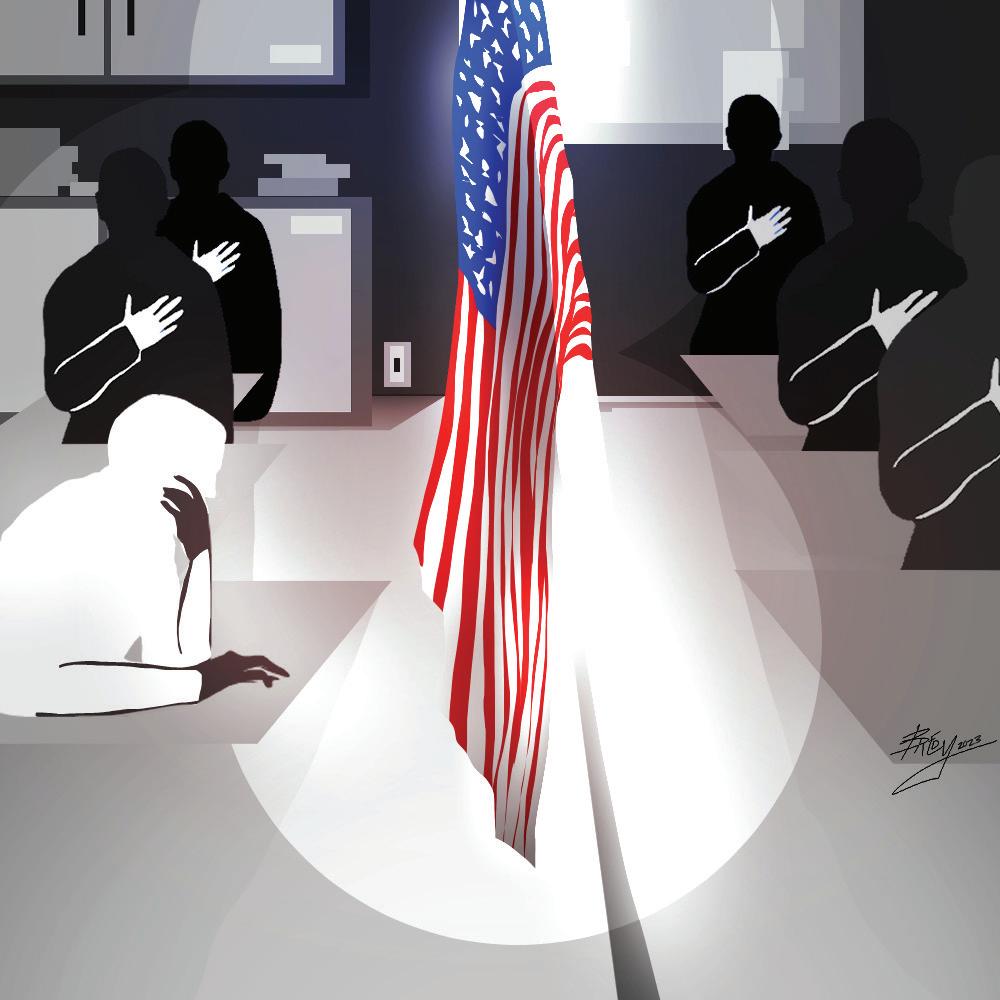
The door to the shop creaked open, a woman peeking her head out to make sure no one else was around before sneaking three men into the back parlor. In hushed tones the men showed her a design: 13 red and white stripes and 13 six-pointed stars. Upon asking if she could sew the flag for them, Betsy Ross is famously said to have replied, “I do not know, but I will try.”
But this is all speculation. Despite commonly being taught as the true story, there is no written or physical proof that Ross was the first person to sew the American flag, just a seamstress who had been commissioned by Washington for bed hangings who went on to serve the federal government as a flag maker for 50 years.
Predating the stars and stripes we know today, the very first American flag is commonly known as The Grand Union Flag. According to the US District Court of Puerto Rico, it was first flown on Dec. 3, 1775 by a Continental Navy lieutenant named John Paul Jones. Its design consists of the familiar 13 stripes, but lacks the stars. Instead, it has the British Union flag and is commonly acknowledged as the first US flag in a number of displays.
But despite having an official flag for 117 years and being officially recognized as a country for 109, we didn’t have a Pledge of Allegiance until 1892, something that author Francis Bellamy set out to fix.
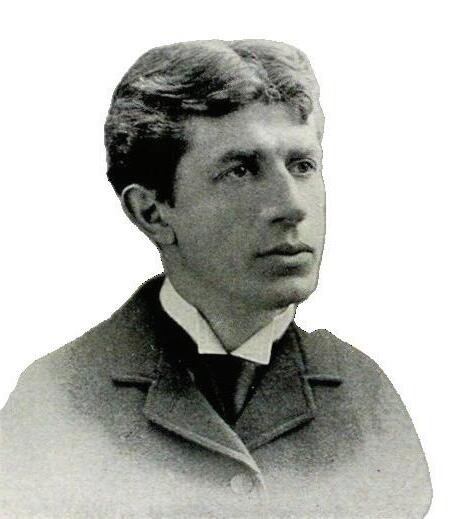
According to an article in the Smithsonian Magazine by Amy Crawford, the whole process started as something of a marketing scheme. The Companion, the country’s largest circulation magazine where Bellamy had worked for two years, was offering US flags to those who sold subscriptions.
In conjunction with Christopher Columbus’s 400th anniversary of landing in the Americas, the magazine planned to raise the flag “over every Public School from the Atlantic to the Pacific” with a matching oath.
For the most part, they got their wish. As we all know, schools across the country still recite it daily, just not the same one originally penned 131 years ago.
Over the years, the pledge evolved alongside the country. It underwent its last alteration in 1954, which saw the addition of the words “under God,” to create the 31 word pledge we say today.
Yet the words aren’t recited alone. Along with our new pledge, there was also a new salute.
The Bellamy salute, despite the name, wasn’t ac-
tually created by Bellamy. James B. Upham created it in the same year to go alongside Bellamy’s pledge.
The original salute was palm-out and pointing towards the flag, inspired by the ancient Romans who are believed to have greeted each other with a similar gesture. However, this was changed drastically during World War II, as Italian fascists and Nazi Germans adopted a very similar salute.
In 1942, it was officially changed to the hand-over-heart salute when congress amended the United States Flag Code, which establishes advisory rules for display and care of the flag.
So, with all the history laid out, one question remains: should we stick with the notions and ideas of people who lived over 130 years ago when the world was a wildly different place, or is it time for an upgrade?
That, reader, is up to you to decide. Ross, Bellamy, and all the other founders of figures still significant today had no idea what their country would eventually evolve into, but they did place their trust in the people of said country to uphold the ideologies that spoke to their hearts.
It is up to us to decide if their ideologies, and the symbols that represent them, are still relevant today–or if the founding figures words are due for a rewrite.

ince I was in preschool, before I even knew the meaning of what I was doing, I stood up, placed a hand on my heart, and recited the Pledge of Allegiance. The words will forever be ingrained in my mind.
In fact, according to The Hill, 47 U.S. states require the Pledge of Allegiance to be recited daily in public schools. However, in 1943, it was determined in the Supreme Court ruling West Virginia vs. Barnette that “no school or government can compel someone to recite the Pledge of Allegiance or salute the flag.”
Many students have differing reasons for why they do or do not choose to stand for the Pledge, whether the choice be based on personal beliefs, relative experiences, or even family viewpoints.
“Honestly, it’s something my parents taught me, always be respectful to people that lost their lives overseas,” sophomore Seth White, who stands, said. “Nobody that I know served in the military, but I still think it’s important to have at school.”
On the other hand, junior Claire ‘Graham’ Baijnauth,
1998
In Florida, Michael Newdon, an atheist, tries to get the rid of the phrase ”under God” removed by filing a suit against the school board of Broward County. This suit was dismissed and the phrase remained.
Disputes over the phrase
begin
the child of an immigrant and member of the LGBTQ+ community, does not stand for the Pledge of Allegience.
“I’ve experienced a lot of racism and prejudice,” Baijnauth said. “I struggle every day standing up and pretending to care about a country that doesn’t care about me.”
A view of neutrality to the Pledge has also become common among the student population, including that of junior Caedan Vetro, who feels that there are better ways to praise the ideals of the United States and those who have fought for it than reciting the Pledge of Allegience every morning.
“I can get behind soldiers, but I feel like I can support it in different ways than standing for the Pledge. It just seems like a chant.” Vetro said. “I’ve gotten to the point where I don’t really care that much. In general, I’m really more of a citizen of the world rather than just this country,” Vetro said. “I get that people stand up for it, but personally, it’s not so much for me.”
Around the school, students show respect for the opinions of others, whether they are similar or different from what they believe.
“I wouldn’t say it’s disrespectful [to sit for the Pledge], they [soldiers] fought for you to be able to have your own opinion, have your own thought process,” White said.
According to the Nebraska Council of School Administrators (NCSA), Nebraska students are not required to stand for or recite the Pledge, as long as they are silent during the Pledge, to respect those who do choose to stand. However, students are not often explicitly informed of this right.
“You are within your constitutional rights to not stand for the Pledge and not to say the Pledge, but that’s never something that’s advertised or spread. It feels weird because you’re not telling these kids or educating these kids that you don’t have to,” Baijnauth said.
With students making their own choices regarding the Pledge, a lot of variety can be seen in MN classrooms.
“I think it’s good to have a variety of it, so it’s not seen as forced anymore,” Vetro said. “People should be able to do whatever they want.”
Each student is entitled to a choice. We all get to stand (or sit) for what we believe in.
(out 61 MN students)
2000 Disputes continue
In 2000, Newdon files another lawsuit. This lawsuit was against the Elk Grove Unified School district in California. He argued that forcing students to listen to “under God” in the Pledge is a violation of the First Amendment. In 2004, the Supreme Court again dismissed this case.

“No court created by Act of Congress shall have any jurisdiction, and the Supreme Court shall have no appellate jurisdiction, to hear or decide any question pertaining to the interpretation of, or the validity under the Constitution of, the Pledge of Allegiance, as defined in section 4 of title 4, or its recitation.’’. The limitation in this section shall not apply to the Superior Court of the District of Columbia or the District of Columbia Court of Appeals.”
Newdon, along with the support of parents in Sacramento, California, file a new lawsuit to get the phrase removed. in 2010, the 9th Curcuit US Court of Appeals denies Newdon’s appeal. They didn’t agree that the Pledge with the phrase “under God” represents a government endorsement of religion (which is prohibited in the Constitution.
The Pledge Protection Act was passed
2004
“under God”
Americanism or American Patriotism means something different to all of us and it is a characteristic that is shown in American high schools. To some it is loving your country in school by standing for the pledge every morning in remembrance of the sacrifices that were made for us to be here.
“I think that if someone chooses to sacrifice their personal time to go and serve their country and people, I think that is a really honorable thing to do and really respectable. So when I have the chance to stand up for the pledge I choose to do it because I think of them and their sacrifices and what I can do for them,” senior Rachel Louthan said.
In many ways in school we associate patriotism with the Pledge of Allegiance. It is an aspect that is is unique to American culture. It’s one of the only countries that says the pledge every morning before school. For most other countries, the Pledge of Allegiance can seem like a nationalistic practice that challenges democracy.
“I think American society is more patriotic than Spain. I mean if in Spain there were something like the pledge of allegiance, people would complain and no one would do it because it’s like they are making you love your country,” senior foreign exchange student, Paula Minchot Gracia said.
Though some individuals might feel forced to feel patriotic in school, there are also others that genuinly are. They love America.
“I would say I am patriotic because I just like the government and where I am living and what is going on and I am happy that I was born in the United States,” senior Anthony Audsley said.
The Pledge of Allegiance is not the only way pa-
Patriotism is part of the learning process in high school and is taught across history classes. In Millard North the history classes are designed with inquiry based education which allows students to question and discuss the history of America. Students are allowed to discuss the strengths and weaknesses of patriotism alike. They discuss the importance of patriotic unity that creates strength, shared values and goals. Students are also able to discuss the dangerous aspects of Patriotism with the help of teacher to guide the discussion.
“As the grownups in the room, how do we convey the messages of the tightrope of, where does patriotic and proud end and where does it start being destructive. That is a discussion that’s best had intelligently with help a from a teacher and input from students,” Diehl said.
In other words, there are many different factors that are put into teaching patriotism in schools. Millard North teachers have their unique ways and specific values that they believe are important to American ideals.
The Pledge of Allegiance is patriotic not relgious. Therefore, saying “under God” in the Pledge of Allegiance is not discriminating against atheist.
triotism is implemented in school. Patriotic Beliefs is taught throughout American schools, Nebraska included. The Nebraska Legislation in Statue 79-724 says, “--arrange its curriculum in such a way that the youth of our state have the opportunity to become competent, responsible, patriotic, and civil American citizens.”
New Jersey Supreme Court upholds including “under God in the Pledge during the American Humanist Association v. 176 court case.

India Landry was expelled from Windfern High School in Houston, Texas because she refused to say the Pledge. Her mother sued the principal and the school district.
2019
“At least here [MN] the value is very much criticism, critical understanding and asking hard questions is patriotic. That is the method of self improvement. And we are, as the state document says, in order to form a more perfect union, we’re an unfinished product that must constantly ask itself, are we doing the right thing,” Rohde said.
Patriotism can be seen through the hallways of MN and the American values that each student believes to be an important American principles.
In 2019, Robert Miller, the president of Santa Barbara City College Board of Trustees decided to stop saying the Pledge during meetings because of the phrase “under God”. This resulted in media coverage and backlash. The board later announced that the Pledge would be reinstated during meetings.
As of 2012, the School Board of Education requires all public school to dedicate a period of the day to recite the Pledge of Allegiance. However, students may choose to not recite the Pledge and have the right to silently stand or be seated during this time.
“As the state document says, in order to form a more perfect union, we’re an unfinished product that must constantly ask itself, are we doing the right thing
SIMON ROHDE MN SOCIAL STUDIES TEACHER
The expression of your identity is what makes you unique as an individual. It changes what others think of you, but more importantly it lets you be who you are, and helps you convey who you are to the world. Identity affects your mental, physical, and emotional health. But what happens if your identity is being attacked?
Just last week, Tennessee’s governor signed Senate Bill 3, which would effectively do this for thousands of people across the State. Now known as the “Tennessee drag show bill,” the bill has been taking news outlets by storm. It says that “a person who engages in an adult cabaret performance on public property– or where it can be viewed by minors– can be charged with a criminal offense.”
While the bill’s contents may sound confusing, the purpose is all too clear– it targets self expression, and more specifically, drag queens.
“Drag is a gender-bending art form in which a person dresses in clothing and makeup meant to exaggerate a specific gender identity, usually of the opposite sex,” as MasterClass puts it.
While the bill’s sponsors say the purpose wasn’t to target drag queens, many such as the ACLU (American Civil Liberties Union), who has been protesting the bill, believe it does this unintentionally.
Tennessee pride officials say that with this bill in effect, they will have to cancel their pride festivals, such as Knox Pride, which 66,000 people attended last year. The funds for this event help survivors of domestic abuse,
Legislative Bill 371
young people experiencing homelessness, and fund food pantries. So, not only is this bill affecting LGBTQ individuals, but also underprivileged people in the community.
“We wouldn’t be able to have drag performances, and that’s a huge part of us celebrating who we are and our community, is having that performance aspect and standing in solidarity with our drag brothers and sisters. It doesn’t make a lot of sense,” a member of the Knoxville pride community said in a WBIR article.
And Tennessee isn’t alone– 12 other states also have bills against drag performers. These states include Arizona, Texas, and our very own Nebraska.
In Nebraska, Bill LB371 was first introduced in January of 2023. The bill states that anyone under the age of 19 shall be prohibited from attending a drag show. Senator Dave Murman is the one who authored the bill, and said that it will help “Protect the children.”
However, Senator Murman also admits to having never attended a drag show performance. He claims that drag shows are inherently sexual and not fit for children, but in reality many drag shows are centered around being safe for children, for example the Drag Queen Story Hour founded in San Francisco in 2015, where drag queens read children stories at public libraries.
Not only is this bill discriminatory, but it is also vague.
“The broadness of its language would make parents guilty of a misdemeanor if they took their 18-year-old child to a show about Joan of Arc, a play in which a woman passes herself off as a man,” UNL Assistant Professor of Law Kyle Langvardt explained.

So far, the bill has not passed, but been indefinitely postponed, due to Senator Megan Hunt, the first openly LGBTQ person elected into the Nebraska State Legislature.
But with bills just like it rising up in multiple states, it is important that we stay educated on them and their impact and do our best to take action against them, so that people can continue to express themselves, no matter who they may be.
Drag show is defined as “a performer which exhibits a gender identity that is different than the performer’s gender assigned at birth using clothing, makeup, or other physical markers”
Charge is a Class I misdemeanor
The Hoofbeat staff will publish six issues of the paper at Millard North High School (1010 South 144th Street, Omaha, NE). Type is set with the use of Macintosh and HP computers. Printing is done by White Wolf Printing, Sheldon IA. The Hoofbeat is a member of the Nebraska High School Press Association and JEA. The Hoofbeat exists for the express purpose of student information and learning.

Advertising: Advertising will be sold at $7 per column inch or by special quarter, half, or full page rates. Information can be obtained by calling 402-715-1404.
Responding to the Hoofbeat: Letters to the editor may be submitted to Room 1105 or sent to sacrotzer@mpsomaha. org. Names will be published. Letters must not contain attacks against an individual and may be edited for clarity.





Co-Editors-in-Chief
Olivia Torrez
Rebecca Jacobsen
Front Editor
Elias Pipinos
News Editor
Rebecca Jacobsen
Opinions Editor
Teagan Lynch
In-Depth Editor
Mahika Kanchanam
Lifestyle Editor
Olivia Torrez
Sports Editor
Sadie Hugelman
Online Editor
Anuj Singh
Social Media Editor
Anuj Singh
Individuals under 19 or 21 in Nebraska are prohibited from attending drag show performances
State funds will not be allowed to be used to fund drag show performances
As of now, this bill is under motion to be postponed indefinitely
Co-Editors-in-Chief
Cartoonist and Artist
Molly Murch
Violet Bredenkamp
Lucy Tu
Photographer
Jack Durkan
Front Editor
Lucy Tu
Staff Writers
Mia Castro
News Editor
Lahari Ramini
Adithi Deeduvanu
Isabel Gross
Opinions Editor
Natalie Hill
Anjali Pullabhotla
Callie Menke
In-Depth Editor
Molly Murch
Emily Schmucker
Uzin Shrestha
Lifestyle Editor
Cece Vlieger
Isa Luzarraga
Sports Editor
Amina Hussain
Lily Taylor
Grace Evert Adviser
Online Editor
Sarah Crotzer
Sireen Abayazid
Principal
Social Media Editor

Aaron Bearinger
Gracie Schweers Adviser
Sarah Crotzer
Principal
Brian Begley

 Uzin Shrestha Staff Writer
Uzin Shrestha Staff Writer

n average American household can contain upward of hundreds of thousands of items, which can range from a desk to a book. Some of these items we own multiples of: six water bottles, twelve lip glosses, seven watches, five perfumes. We all just own a surplus of “stuff.”
While consumerism’s power over us isn’t anything new, in the past few years, especially after the pandemic and the surge in social media usage, it has secured an even more firm grasp on us.
Influencers such as Alex Earle and some social media companies have targeted women specifically to buy products and pursue the trendy persona that they see celebrities and other women as. Whether it’s the “clean girl” or “it-girl”, there always seems to be an appealing aesthetic that a majority of women want to achieve.

This leads to people buying certain items to fit into whatever is trendy, and then completely leaving it behind once a new trend starts.
As well as negative social impacts, consumerism has been one of the main reasons our environment is depleting. Once we latch onto the new trends, more and more of our older items end up getting thrown away. This slowly increases the amount of rubbish in landfills and heightens the issues of pollution across the globe.
For example, fashion and beauty are forever changing. The outfits and beauty products from just three years ago are no longer in style. Sherpa jackets, chunky


FILAS and scrunchies are all considered outdated. Nike Dunks, claw clips, cargo pants and Drunk Elephant skincare products are just some of the items considered to be trendy now.


There’s absolutely nothing wrong with wearing chunky FILAS or donning a sherpa jacket to school. However, many would define this fashion choice as being unstylish, “cheugy,” or outdated.
Something as simple as water bottles are also another great example of the negative effects of following trends. Just a few years ago, it was extremely trendy to own a Hydro Flask. Now, due to hype from social media, Stanley cups are all the rage.


In fact, some of my friends left their beloved Hydro Flasks behind to become Stanley cup users. But what happens to their old water bottle? Unless they give it away to someone else, it will most likely end up lying around in some cupboard collecting dust, which will more than likely be the fate of the viral Stanley Cup as well.

Once I distanced myself from consumer culture and practiced conscious consumerism, I no longer felt the need to purchase these “viral” items. I instead look for ways to repurpose my older belongings and avoid buying items that I don’t see myself still enjoying in the next five years. I am now more aware of the things I already own that I could put into good use.
What it boils down to is this: it’s not having a Stanley cup, a certain brand of makeup, or a new gadget that an influencer has that will make us any cooler or feel any better about ourselves. Trends will come and go, and if you try to follow every single one of them, you will be caught in an endless cycle of buying every viral product and never being truly satisfied with what you have once the trend dies down.
If we as a society stop this cycle of buying, we can avoid wastefulness and improve our happiness. We don’t need to own upwards of thousands of items to be satisfied.
Overconsumption has skyrocketed - in the 1960s, Americans bought about 25 items per year, while in 2020, people bought about 70 items per year
Millions of workers must work to fill the demand, many with low pay and terrible working conditions
When more products are made, greenhouse emissions skyrocket, contributing to global warming
Trees that companies source rubber from are now in low supply (13 million metric tons of rubber in 2020)
Items take a long time to decompose. For example, it takes 3040 years for a pair of shoes to decompose once put in a landfill




 EMILY SCHMUCKER Staff Writer
EMILY SCHMUCKER Staff Writer
Colors of all kinds fly through the air. Everyone within reach experiences a shower of vibrant, rainbow powders known as gulal. The powder meshes onto their clothes, sinks into their scalps, and stains their bodies. People laugh, dance, and celebrate the coming of the spring season. This is the festival of Holi.
Holi is an ancient Hindu tradition that embrac es the triumph of good over evil and welcomes the season of spring. Celebrated in early March, Holi is a lively and colorful festival that is all about having fun.



Within MN, a Holi celebration was organized by a group of students-- the South Asian Association.

The South Asian Association is a club new to MN this year and is already making an impact on its members.
“Considering that we have so many special holidays and celebrations, we thought it would be cool to create a group of people that would help cele brate these things within our school to gether,” junior Vishaal Arunprasad said.
The club planned for their Holi fes tivities to be held on March fifth at Zo rinsky Lake. The guarantee of food,
fun, and fellowship made for a special experience.
“People bring food and different games, but the main celebration is the color festival,” Arunprasad said.
While Holi is a festival dedicated to color, white clothes are typically worn to the celebration. After an afternoon of throwing around powders, these garments are now left new and colorful, streaks of rainbows that are woven into the fabric.
“We get to wear [these clothes] as an ex-
“There was food from North and South India, during Holi people eat a lot of sweets,” said sophomore Sumanas Maram. One commonly consumed sweet treat is gujia. Gujia are sweet, deep fried dumplings filled with a mixture of dried fruits, grated coconut, and a milk fudge called khoya. Lots of different curries are served as well.
“I made a curry called chole, it’s chickpeas and gravy and is pretty popular,” said Maram. By organizing events such as Holi, the South Asian Association has helped both South Asian students and students of other cultures embrace and appreciate their heritage.
“It’s helped me get more in tune with my culture. Usually, I’m not very participative in events like this, but now with the South Asian Association, I can spread my culture and let people know how much fun it is to participate in things like this,” Arunprasad said. Non-South Asian students also take part in the club and celebrations. The Holi festival was open for all to attend, spreading the special Hindu culture to all MN students.
“It taught me a lot about how other people celebrate, it was very eye opening,” said senior Yazeed Abayazid
Let this be a sign to take a closer look at those around you, learn about their cultures. Who knows, you might end up at a beautiful Holi festival, or something just as magical.
Bhavya Krishnan: “I thought it was cool that all the grades could do something together and you could just have fun and destress. It was an opportunity to have some fun outside of school and see people you wouldn’t normally.”
Anish Amin: “I really enjoyed Holi with my friends and also really liked the food. It was fun to see everyone get together to celebrate the culture.”




The creamy, flavor-infused milk tea travels through my straw, followed by a small, chewy sphere of tapioca. These are just two of the possible components used to make one of my favorite drinks: boba tea.



Without knowing I was just a pop, sip, and a chew away from deliciousness, I stepped into the cozy atmosphere of the Yumchaa bubble tea shop at South 74th Plaza, Omaha NE.
Inside, the setup was relaxing. People sat and conversed while they drank their tea, and music played softly in the background. The seating ranged from high stools, to regular chairs and tables, to couches, reminding me of a coffee shop.
To make the scene even more inviting, board


menu, I struggled to choose what I wanted to try. There were so many options, ranging from milk teas to fruit teas, and popping bubbles to tapioca and jelly bubbles.
Even though every single thing on the menu sounded amazing, I settled on two drinks. One was matcha milk tea with mango popping bubbles and the other was a brown sugar bubble with milk tea.
The worker at the cash register was very patient and kind, helping me to understand what everything was and ultimately being the one to recommend the drink I bought. The friendliness of the staff made me feel even more welcome and comfortable.


Next, it was time to wait. The service was a little slow, but the final product was worth it.
The drinks were set on the counter and I got increasingly more excited to try them as I plucked two pink straws out of the can also filled to the brim with yellow and green ones. The matcha milk tea looked basic com-
vor and it seemed like I was just drinking plain 2% milk. This is how it was until I thoroughly mixed the drink, and while the flavoring was better, it still came up lacking. However, the tapioca bubbles were the perfect texture. They were easy to chew and, although they didn’t taste like anything in particular, perfectly complemented the creamy milk.
At the bottom where there was more flavor, I was able to get a few perfect sips, where the delectable taste of brown sugar, reminiscent of caramel, slipped across my taste buds and left me wanting more.






Had there been more flavoring to ensure every sip had this satisfaction, the brown sugar milk tea likely would have been one my new favorites.
The matcha was even better. The creamy milk tea was consistently sweet and tasty, leaving just a slight grassy aftertaste behind.
The mango popping bubbles were main-







Mostgirls have experienced getting in trouble for secretly braiding a friend’s hair at the back of the classroom in elementary school or making it the main activity of every sleepover. It’s hard to pass up the opportunity to brag about your braiding skills. However, most of us don’t think about turning this into our own business.

Madison Jensen is currently a sophomore running her own braiding business, which she started three years ago. Taking an opportunity that came her way, she continues to grow her business and learn from her experiences.
“I learned to braid hair when I was 13 [years old] in March of 2020 at a resort’s kids’ club in Mexico. Shortly after that, I went into quarantine, and I was very bored, so I started a Facebook page, Braids & More by Madison, to showcase all my braids, just for fun,” Jensen said.
This casual post is what sparked her business. Viewers of the post started reaching out to Jensen, asking her to braid their hair as a paid service. Seeing this as an open door, Jensen decided to turn a hobby into a business.
“I started getting more serious with my business and made business cards, started an Instagram account, and started advertising on social media. I started the business because I could do something that I loved while making money and helping other people,” Jensen said.
Jensen explained the support she receives from friends and family, who keep her motivated as she works hard to keep her business running:
“My sister and dad have helped me a lot. My sister lets me practice hairstyles on her and take 15 zillion pictures of her hair afterward. My dad works for a beauty supplier, so he helps me get supplies such as mannequins and hairspray when I’m running low. I am so grateful because there have been so many local businesses and people who have taken a chance on me and my business,” Jensen said.
Jensen’s mom, Mandy Jensen, also continues to help with the logistics and behind-the-scenes factors.
DREAM WEAVERzzz is a slumber party service that provides different curated packages which provide each child with their own private tent and all of the slumber party essentials and has teamed up with Braids & More by Madison.

“My role has been driving her around to different parties and events, helping her set up for craft fairs, teaching her about communication and business strategies, and just being her biggest cheerleader. It has been so much fun helping Madison get this little business going, and our relationship has grown because of it,” M. Jensen said.
With her family’s support and her consistent efforts, Jensen’s business has come a long way. Her business gets customers from birthday parties, events like prom and homecoming, craft fairs, or a girl simply needing her hair done for a gymnastics meet. She even does braid-
said.
Jensen’s confidence and accomplishments don’t go unnoticed by the ones around her.
“My husband and I are so proud of what Madison has already accomplished with this little braiding business that she built from the ground up. The primary area of growth I’ve seen in Madison is confidence and poise. Her ability to stand in front of a group of adult women and teach them how to braid is impressive at age 16,” Jensen’s mom said.
Ella Jonas, a friend of Jensen’s, helps Jensen with her business through attending braiding parties and helping braid some of the girls’ hair.
“Braiding parties are a unique service to have a fun hairstyle while at a birthday party. Madison usually does parties for younger girls ages five to twelve that only last up to an hour or two. I really enjoyed helping and it’s fun a fun way to meet new people while doing something you’re good at,” Jonas said.
Jonas enjoys working with Jensen and continues to see her grow her business. She admires not only Jensen’s motivation, but passion for her business.
ing classes.
“When I started my business, I only did a couple of styles, but now I can pretty much do any hairstyle someone requests. Also, in the beginning, I would have one person reach out every couple of months, but now I average about one person a day reach out,” Jensen said.
As she faces challenges along the way– like having to tell a customer she had to cancel or reading critiques online– she learned how to get past her obstacles. This business teaches Jensen very valuable lessons that she would carry with her.
“I have learned a lot about how to manage money along with figuring out how to utilize social media to my advantage and keep track of my expenses, income, and taxes. But most importantly, I have learned how to communicate with people. I learned how to talk to adults and other business owners in a professional way. I also learned how to communicate with customers,” Jensen
“[Madison] continues to impress me with her creativity and passion for finding things she truthfully enjoys. She constantly talks about ways she wants to solve
Braids & More By Madison on Facebook and Instagram promote Jenson’s business by providing platforms to keep customers updated on future public event locations, specific services, and provide places for customers to ask questions, see offered styles, rate service, and leave feedback

“ She’s able to engage her audience and find any oppurtunity to get others excited about what she does.
n ambitious group of high schoolers take the “W” as they make their own intramural teams. Earlier this year, the soccer team, SWFC and basketball team, CBC sparked widespread enthusiasm with their intramural high school sports teams. Compared to traditional high school athletics, which tend to be high pressure and highly competitive, these high schoolers have created a space that allows for fun, light-hearted competition.
The idea of SWFC was sparked by sophomore Luke Ehle and his dad Robert Ehle. The Ehle family helped fund and spread interest towards an off season, indoor soccer league that would not only help with team chemistry, but also build anticipation towards the 2023 high school spring season.
“We were bored. Some people didn’t have practice and some [club teams] were kind of winding down and we wanted to have something to do to get hyped before the high school season. So we made the team,” Goremusandu said.
Once the soccer team had formed, the boys realized they needed a coach. Junior Kuziva ‘Taka’ Goremusandu was up for the challenge and it was a natural fit, as he was coming off a prior injury.
“Well Luke’s dad had made the team but since I couldn’t play. (and) I wanted to be a part of the team. I became a coach,” Goremusandu said.
While the SWFC already had an established team history through the boys soccer teams, the CBC started fresh this year and came together for the first time to create not just another YMCA team but one of the greatest the Y has ever seen.
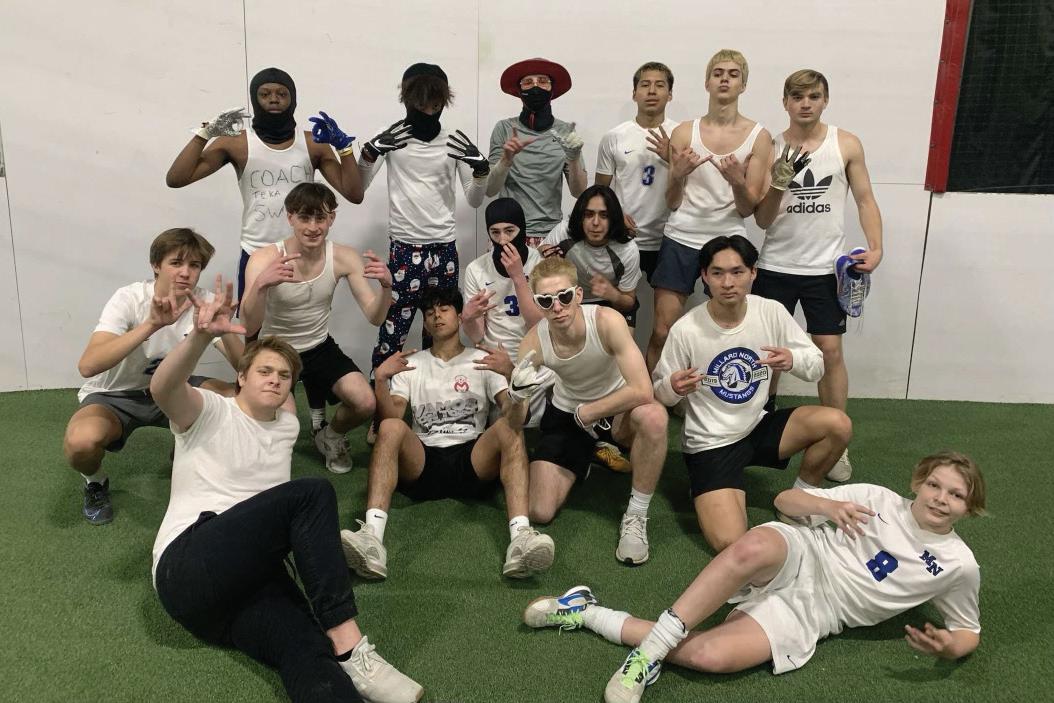
Current coach of the CBC junior, Arjun Anugole expressed how his team came from humble beginnings, as just a group of friends who wanted to have their chance to make their mark on the court.
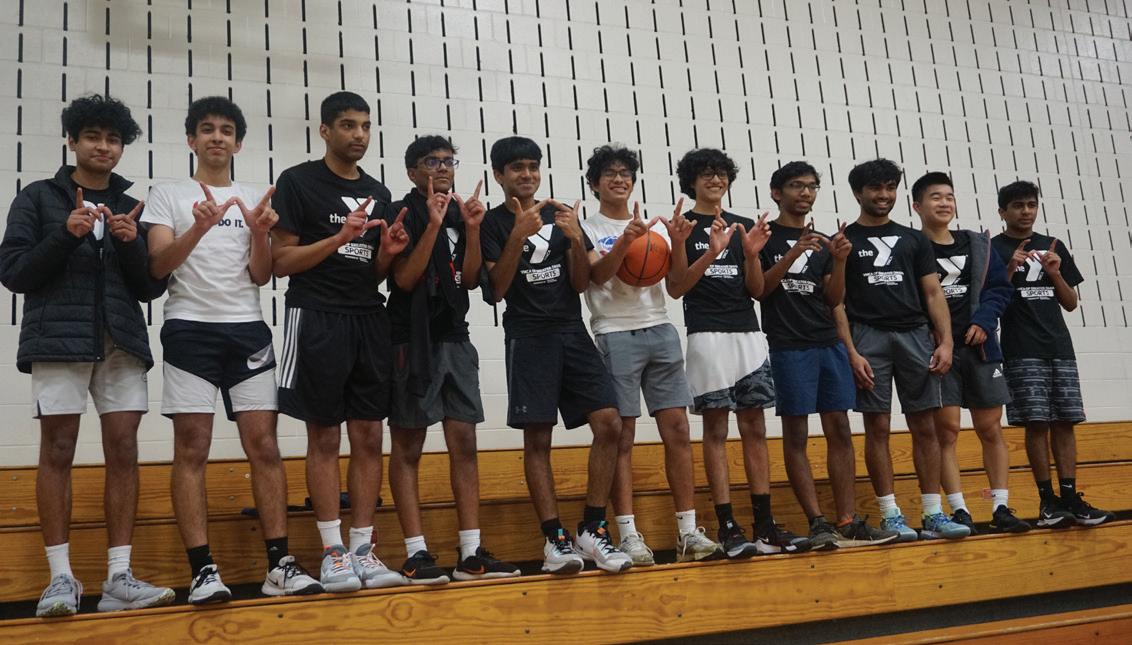
The CBC team poses for a picture after winning their game. The team played against the SWFC for their final YMCA game.
“We kind of just created it so that we could have fun playing basketball, because we don’t really want to do that (as a school sport) or have the time to play for Millard North so we just want to play for fun on the ‘Y’ (YMCA) team,” Anugole said.
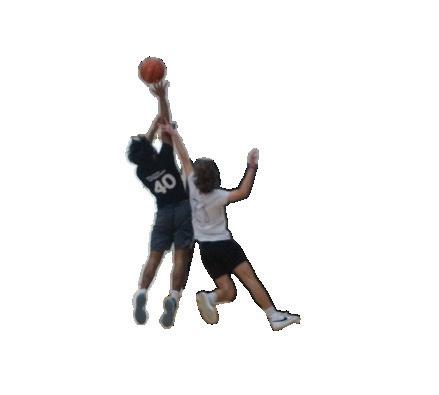
As long time friends, it can be hard to put someone in the position of leading the team. The CBC faced the challenge of who would lead as the coach. Star player and junior Arehant Arun expressed the answer was clear from the beginning.
“For the coaching we wanted a coach that was very harsh and knew how to best out of each person. We thought Arjun perfect one because we know that he’s not go hold anything back. He’s going to tell every straight to our faces. So he was perfect for that,” Arun said.
While finding a coach was easy, the basketball team then had the task of picking out the perfect name. In the end the team decided to take a more humor ous approach.
“CBC stands for Chandhi Basketball Club. Chandhi is just kinda a fun Malay alam word. It doesn’t really mean anything, it’s just kind of a fun name for us. -We just like saying Chandhi,” Anugole said.
When it came to game days the CBC had to face the challenging question who would start off the game. Arun de tailed that they had to look at the logis tics of each player in order to allow the to start off strong on the court.
“For the starting rotation that was mainly based on everyone’s skill sets. Like size and athleticism. We just wanted to put the five best players out there,”Arun said.
The CBC all had big takeaways from this season. For Arun it was the memories and the lessons he learned
along the way that he feels he’ll remember off the court too.
“I learned a lot about teamwork, because this is the first time I’ve actually been on a team and I mean there’s a lot that goes on that I wouldn’t have really thought of before. Like you can watch a bunch of people play basketball, but you don’t really understand everything that goes on behind the scenes of each practice, each game,” Arun said.
The name SWFC is a little more sentimental than humorous. This team wanted to show their MN roots by dedicating their name to the head boys varsity coach, Sandros DeAngelis himself. SWFC stands for Sandros Warriors Football Club.
SWFC also had to make the tough call of who the starters would be. Goremusandu expressed that their meth - od took a rather inventive approach to the matter.
“For starters, sometimes we’d do rock, paper, scissors. If not (rock, paper, scissors), we looked at who played better the game before,” Goremusandu said.
Senior Tony Rosales, starter of the SWFC felt that this season allowed for the team to connect and learn to have fun with each other. He believes that SWFC was able to break down group barriers and bring boys soccer all together.
“We all grew closer. We used to go out to eat and we would play together. We had a ton of players on the team that play Varsity and JV, it was a mix, so now we all like each other JV and Varsity no matter what we play,” Rosales.
In finding names, picking coaches and playing games, both the SWFC and the CBC have gone through trials and triumphs. Each player learned not only about what it means to be on a team, but what it means to be a team player. All and all, these boys be ballin’.
The SWFC team captures a fun moment after winning a game. The team met up with the CBC for a game of football.
The wrestlers are warmed up, hydrated, and ready to go. The bout is about to begin. Into the ring step… two girls?
From February 16-18, athletes from all over Nebraska gathered in the CHI Health Center to prove their skills in the state wrestling tournament. This year, for the first time ever, MN sent not one, but two female wrestlers: senior Hailey Siebrass and freshman Makenzie Martin, the team’s MVP for the season.
“[Going to state] was one of my biggest goals in wrestling altogether, so it really meant a lot to be able to just stand down there on the mats and look up and see the stadium full of people,” Siebrass said.
The three-day event was split into many rounds, all leading up to finals. Roughly half of the rounds were scheduled to include girls.
“It was definitely fun,” Martin said. “I saw a lot of girls I know from club wrestling and other places.”
With Siebrass going 2-2 and Martin 1-2, the girls set the precedent for future female competitors from MN.
“I was really proud of my performance in one of my matches,” Siebrass said. “It was a really good show and I put out some good technique. [The other girl] was crying the whole time.”
Christina Hansen, head coach of the girls’ wrestling team, returned for her second year of coaching MN and is extremely


Practice to Perfect: Senior Hailey
Siebrass practices a hold on girls wrestling coach Christina Hansen. For the past two years Siebrass has wrestled for the MN girls wrestling team, paving the way for other girls.
proud of how far the girls have come.
“It gives me such a sense of purpose to see each girl on the team grow into a wrestler but more so grow into themselves,” Hansen said. “I get to watch their personalities come out and watch each of them develop into more confident and daring individuals.”
Before official teams were instated, many girls found themselves wrestling on teams predominantly made up of boys.
However, with MN officially starting the girl’s wrestling team last school year, it’s given the girls the opportunity to fight and earn their spots in the ring.
“My little brother wrestles, and one day when I was little I asked my dad if I could go to practice,” Martin said. “He said if I could make it through the practice he would buy me wrestling shoes, and that’s how I got started.”
In previous years, the lack of female representation in the sport has made it anything but easy for girls to get involved.
“Starting on boys’ teams, it was hard getting into it,” Siebrass said. “When I first started, you would never hear of a girl who wrestled. Now it’s gone from me being the only girl wrestler I’ve ever known to there being hundreds in the state of Nebraska.”
With more opportunities for girls’
Members of the girls wrestling team meet on the mat during pratice. This is the second year that MN had girls wrestling as an NSAA sport.
wrestling opening up, there has been space for young women to improve in the sport and learn lessons through it.
“It’s an individual sport, so you have to be very independent,” Martin said. “You have to be mentally tough, and I’m not always very good at it, but I’m getting better.”
Overall, Seibrass and Martin agree that their time wrestling has been well spent, and both plan to continue in the future, with Martin hoping to compete in the state tournament throughout her high school career, and Siebrass receiving a full scholarship to wrestle in college.
“It’s taught us to be really strong and confident in ourselves, and helped our ability to learn from our mistakes,” Siebrass said.
While this year’s state tournament has passed, the girls’ wrestling team looks to the future, with hopes of competing on a statewide scale for years to come.
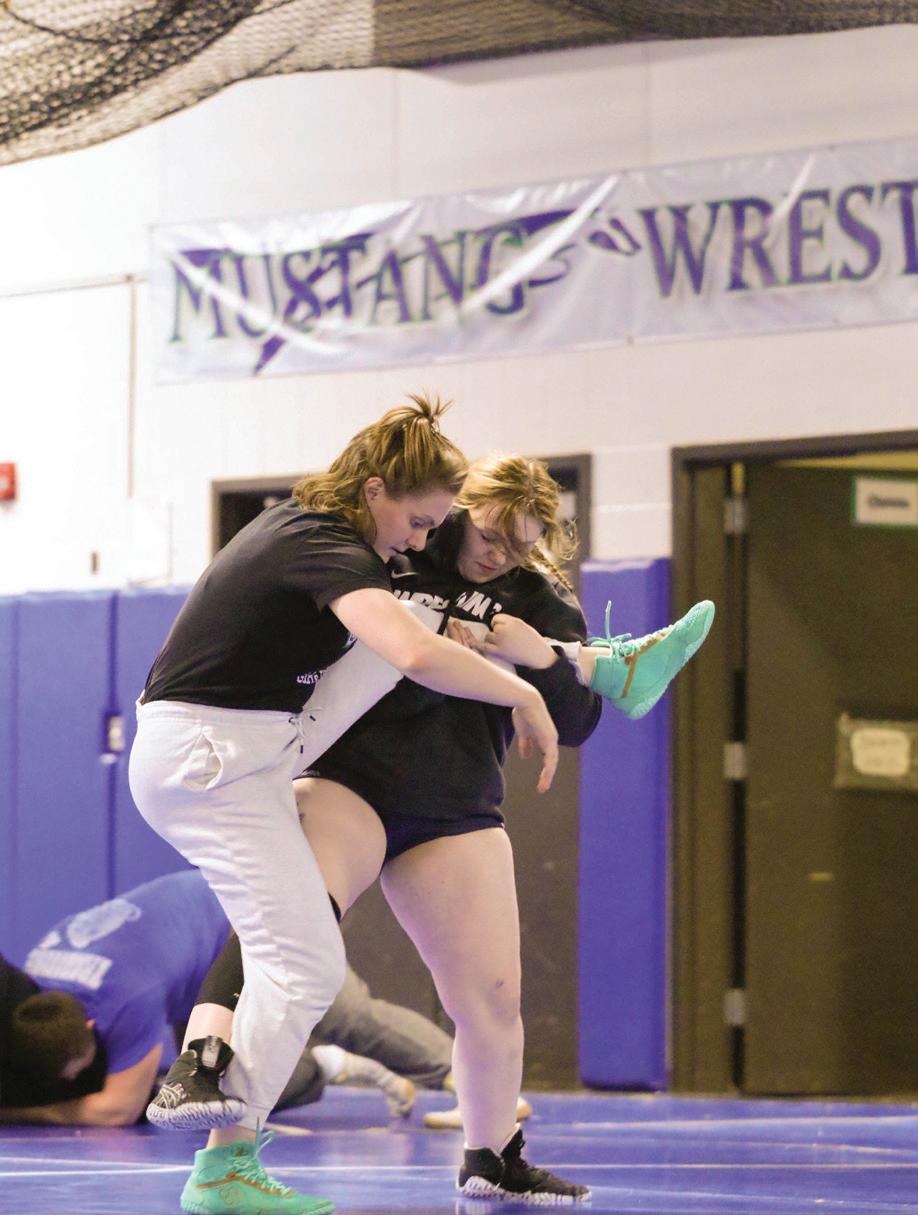

Starting wrestling at age 13, senior Hailey Siebrass looks forward to continuing her wrestling career in college after a pioneeing career at MN 1st State Qualifier in MN History, along with freshman Makenzie Martin.
Full ride scholarship to wrestle at Southeast Community College in Beatrice, NE.
Iof support is minimizing the importance of and decreasing the funding for female athletics.
To combat this, the NCAA has tried to use March Madness branding to promote the women’s tournament, but this leads one to wonder why they only took the initiative now. After accusations of neglecting female sports, the timing seems a little too perfect.
A study done by USA Today in March 2022 found that the average pay for a women’s collegiate basketball coach is $750,000. In contrast, the average salary for a men’s collegiate basketball coach is nearly $3.1 million.
GRACE EVERT Staff Writer
f you were asked to name five teams playing in this year’s March Madness tournament, could you do it? The only catch, they have to be women’s teams. Chances are if you filled out a March Madness bracket, it’s for the men’s teams. But why?
In 2022, an estimated 10.7 million people viewed the men’s tournament, while only 4.8 million viewers watched the women’s games according to ESPN Pressroom. In addition, for every dollar spent on a women’s team, three were spent on a men’s team.
This gap in expenses and revenue only grows as you look at professional sports. Women’s professional sports make and receive fractions of what men’s sports do. To sum it up, sports culture is designed around male athletics.
For as long as sports have been loved, male sports have received more attention. And there is no lack of performance on the women’s side. Women have been breaking barriers and setting records at the same rate as men.
The US women’s soccer team, for example, won the World Cup in 2019 yet had to pursue a gender discrimination lawsuit for equal pay that wasn’t finalized until February 2022.
It is simply less likely for fans to hear about women’s games than men’s games in the same sport. And this lack

“I would make [the team] run across the tennis courts like all coaches do. I would make them do burpees and then I’ll let them go.”
Many argue that women’s sports would get the viewership and love if they were worthy of it, and that female sports are just less exciting to watch. However, the media companies whose camera angles and commentators make a game exciting to watch are the same companies neglecting to put their funds into women’s sports. A women’s game may seem less exciting if it has one camera angle for every four found in a men’s game.
In addition to less media effort during women’s games, fewer companies broadcast women’s sports. A study done by Buick found that women receive 10% of media coverage despite accounting for over 40% of the players.
Outside of statistics, there will always be an undeniable physical difference between men and women. However, a glass ceiling based on physicality sounds all too similar to those previously experienced by paralympic athletes. Glass ceilings undermine those we all love in sports, the underdogs, the hard workers, and the rising stars.
And no, not all women’s sports are underrepresented. In tennis, swimming, gymnastics, and ice skating women have near equal representation and attention when compared to men.
Individual sports tend to see more equality as they are typically broadcasted as a tournament including both men and women, and people find the “skill gap” (or that they perceive) to be less between individuals as compared to teams.
Despite progress, there is still a lot of work to be done. As fans of sports, we should turn our attention to the long-neglected world of women’s sports. Female athletes are just as deserving of the pay and recognition that men receive, and it’s time to give it to them.
Do you think there’s a difference student turnout for boys’ games vs girls’ games?
I have to agree with the fact that the boys games have more students in attendance than the girls games.
Where do you think this issue comes from?
I think part of the issue is that the biggest majority of students coming to games is the male student body, which is why more show up for the boys than the girls. I also think part of it is that not many people know when the basketball team plays and they don’t know just how fun it is to cheer on the team, and how much we appreciate them coming.
How do you think we could combat it?
I think the best way to combat this is to get the word out there more. We need to have people who are encouraged and want to be at the games to cheer us on. I also think it applies to all activities at MN. When people show up for us it makes us want to show up for them. We all need to understand that we are all Mustangs and we need to support each other!
What would you do if you could be the coach for the day?
Connor Michaud SENIOR Baseball“If I could be my coach for the day I would get more gear and try to get us to practice more and have more team bonding activities.”
Dillon Rose JUNIOR Track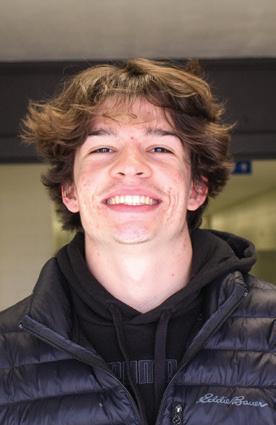
“I would coach a track meet. Just like a random, surprise track meet. At 8 a.m. I would email all the schools [and say] we’re having a track meet today.’”
